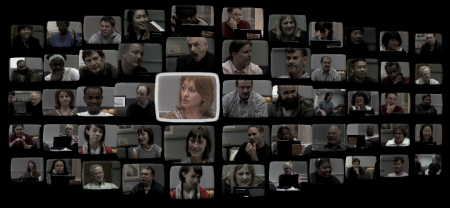Dissecting Microsoft's Mojave Experiment

Last night, as I was drifting off to sleep, something stuck me about Microsoft's Mojave Experiment that hadn't clicked when I first watched it. Out of the 140/120 participants (the number varies depending on the source) that Microsoft say took part in this experiment, we don't actually seem to hear from that many. Why?
The Mojave Experiment is like "The Pepsi Challenge" but where participants have to judge which is the best drink based on seeing someone else take a sipAt first blush, I think that you're supposed to believe that you're being presented with the views of all the participants, but when you actually count the screens, you see that there are only 55 on offer. OK, 55 out of 120/140, not bad ... but ...
Take an even closer look and what you find is that not all of the 55 video snippets on offer are either by different people or for that matter unique. Of the 55, six are a montage of clips used elsewhere. What you also realize is that several of the participants appear more than once on the page. Now I didn't think that this was all that odd, after all, some people are better in front of the camera than others. However, what did hit me as odd was finding some of the videos are duplicated in the Flash presentation. For example, row 1/column 7 and row 5/column 6 is the same sequence, as is row 2/column 7 and row 5/column 10, and then there's row 4/column 3 and row 5/column 5, oh, and row 4/column 2 and row 5/column 7.
One video also seems to have been removed (row 1/column 4) seems to have been removed. In this clip the woman seemed more interested in the fact that Microsoft had made a box for the fake Mojave software than anything else and wanted to know if it was a brick inside the box (the salesperson assured her that there was software in the box, just not Windows).
Once you eliminate the montages and people who appear in more than one clip, you end up with 35 participants who actually appear on screen (35 if you exclude the woman talking about the box, who seems to have been removed from the experiment). It's possible that a few extra people show up in the montage clips, but these are far too brief for me to bother trying to ID them. Given a pool of over 100 participants, I would have expected to have seen more faces, and definitely no duplicates. The way it looks to me is that Microsoft had a hard time filling the 55 available spaces with good commentary about Vista.
Several readers have asked me for my opinion on the experiment. Well, in my opinion, what you are seeing are a bunch of people pre and post receiving a sales pitch. We all know how effective a good salesperson can be (just think of any time when you, or someone you know, has been lumbered with something they didn't really want because of an effective sales pitch) and the effect here is no different. Also, all these people were lured in on the false promise of being shown a brand new OS, not Vista. That kind of build up generates higher levels of expectation, so many of these folks would have been pumped about Mojave before the experiment started. Then there's the fact that all these people had never used Vista before, and therefore have no questions or concerns that they can pump at the sales folks. You also never see any of these folks actually try to do something for themselves, so they are basing all their opinions on watching someone else work with Vista (The Mojave Experiment is like "The Pepsi Challenge" but where participants have to judge which is the best drink based on seeing someone else take a sip). Bottom line, I think that while the set up of the experiment was clever (maybe even devious), the outcome is vacuous to say the least.
But ... maybe the personal trainer effect that we see here shows just how important the Apple Stores are in making Apple (and the Mac OS) a hit with users. A ten minute demo and "BANG!" they're sold.
Thoughts?
